![]()
The Words of the Reinig Family
|
|
The Words of the Reinig Family |
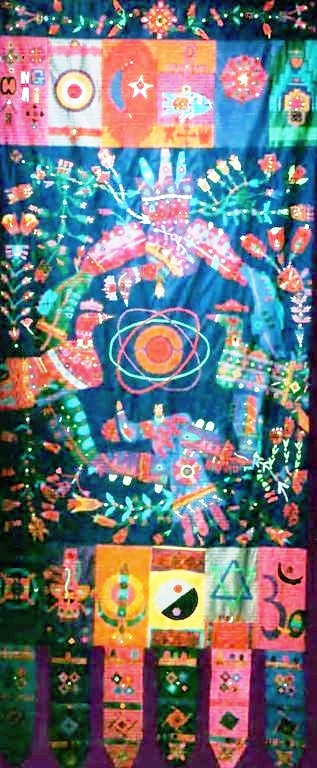
The
main Assembly banner, created by Norman Laliberte, shows the Assembly
logo surrounded by four birds, representing the four corners of the
earth, with overlapping wings symbolizing world unity. At the top and
bottom are symbols of the participating religions.
It is the evening of November 15, 1985. Chief Richard Snake of the Delaware Indian Nation, a noble tribe that once lived on the land he now stands on, lights a ritual fire of evergreen sprigs in the center of a large circle, representing the cosmos. In prayer he invokes the presence of the Great Spirit. Into the center from four points, symbolizing the structural lines of our earth's sacred geography, come a Buddhist, a Hindu, a Jew, a Zoroastrian, a Muslim, a Christian, a Taoist, and a follower of African primal religion, to light a candle from the common flame, symbolizing the interconnectedness of all faiths. Each one recites a prayer from his or her own classical religious heritage in its original language and then calls upon all those gathered around the circle to recite the prayer again in English. Surrounding the circle in the semidarkness, over 600 spiritual leaders and seekers from 85 different nations of the world, symbolically representing all the peoples of the earth, past and present, stand together to take part in this sacred ritual. They are here on a pilgrimage to share the jewels of their own faiths with each other and to discover that their faiths are all drawn from one common source, "that Ultimate Mystery, Memory, Mind, and Heart from which all energy comes!'
Thus began the first Assembly of the World's Religions, held November 15-21 at the Americana Great Gorge Resort in McAfee, New Jersey. Professors, clergy, artists, students, spiritual leaders, and professionals in many fields were invited from all parts of the world to take part in this historic event. Sponsored by the International Religious Foundation (IRF), this conference was the first in a series of three inter-religious and cross-cultural conferences commemorating the centennial of the World's Parliament of Religions, which was held in Chicago in 1893. Assembly Two is planned for 1989, and Assembly Three for 1993.
This incredible event was the manifestation of a vision for inter-religious unity that Father already had 40 years ago. At that time Father wanted the religious leaders of the world to join with him in his urgent quest for dialogue, harmony, and action to help solve the injustices of the world. Now, beginning with this series of three conferences, Father is hoping to recover the primacy of the spiritual dimension of life in the face of the growing secularity of modern society, so that religious people can actually work together and fully contribute to world peace.
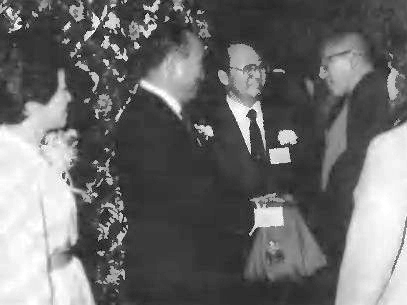
Sun
Myung Moon and Hak Ja Han in the receiving line.
To bring out the spiritual aspect, the Assembly sought to create, not merely a forum for theological discourse, but an atmosphere for direct religious experience -- through dialogue, lectures, meditation, prayer meetings, rituals, poetry readings, musical and dramatic performances, art exhibitions, and film and video presentations. In this way, participants could go beyond the dogma and doctrine that separate religions, and journey into the deep inner aspect, the spiritual center of life, or the heart. For it is only in the heart that true communication with God can occur; only through the heart can one receive real nourishment from and offer real compassion to one another.
The title of Assembly One was "Recovering the Classical Heritage' Participants had the chance to revive the beauty of their own diverse classical traditions and awaken to the richness of other faiths. It was truly a feast for the eye, ear, mind, and heart.
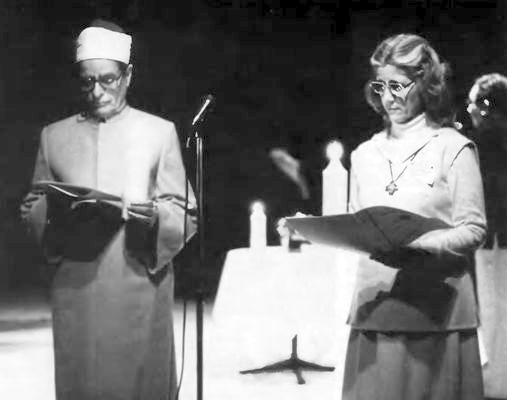
At
the Assembly's opening convocation ceremony, representatives from the
world's religions, having received the light from the common flame,
prepare to recite their traditional prayers.
The spirit of celebration was bounteously manifested in the many-hued banners hung all over the hotel for the occasion, created by the famous banner-maker Norman Laliberte. Symbols of each religion were stylistically rendered in blazing color, adding greatly to the aesthetic environment.
The week began with an opportunity for everyone to greet Father and Mother, Rev. Chung Hwan Kwak, Dr. Bo Hi Pak, Program Chairman Richard Payne, Project Advisor M. Darrol Bryant, and Dr. Huston Smith, a long-time ICUS and IRF supporter. Father greeted each one of the participants heartily with both hands and a big, radiant smile. The seemingly endless line of people offered a vivid display of turbans, cloaks, saris, robes, and habits -- the diverse garb of the world's pilgrims. A number of the guests had been former participants of the Youth Seminar on World Religions, and were very excited to shake hands with Father and Mother. A majority had never been to an event sponsored by Father before, but had been invited through many PWPA, IRF, and other church contacts throughout the world.
After dinner the participants gathered for the opening ceremony, the spiritual con- vocation described above, which included delicate yet penetrating Middle Eastern melodies performed by the Alhambra Trio. Even from the very beginning of the conference a sense of awe and a shared transcendent experience connected each person there to each other and to a higher Presence.
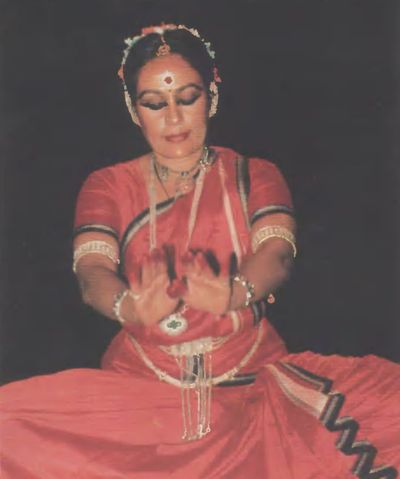
Mrs.
Sonal Mansingh, with painted fingers, evokes the spirit of the Hindu
gods in her classical Indian dance.
At noon the following day the participants gathered for the opening plenary session. Theologian Dr. Herbert Richardson introduced Father. He shared how Father had been asked by God to implement the unity of the spiritual and the physical aspects of man and bring about the building of the Kingdom of Heaven on earth. Then Father gave his Founder's Address in which he stressed the need "to purify the religious atmosphere into one in which believers can have living faith and every soul can communicate with God!"
"All religious people should feel responsibility for the shaky spiritual foundation of this generation and should repent," he said. "Religions should stimulate spiritual…
During the entire week, meditations in the varied religious traditions were held every morning before breakfast in six different rooms. Participants could join in the services of their own or of other faiths. In this way they could experience a real taste of the heart of each religion. It was also a challenging opportunity for the participants from different denominations or sects within the same religion to create a worship service that reflected not just one aspect but the essence of that faith.
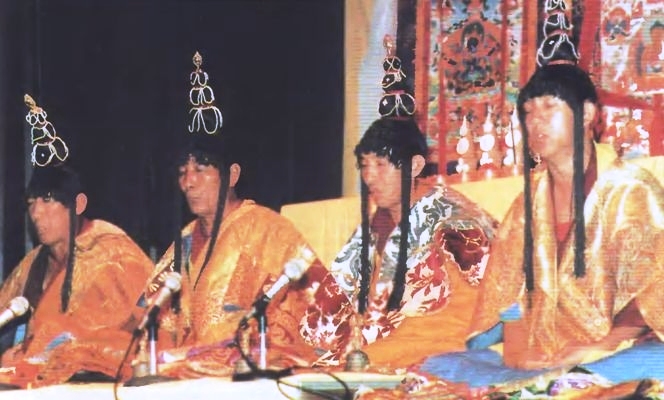
The
voices of these four Tibetan Buddhists mingled sonorously, almost
hypnotically, through the auditorium on the evening of traditional
religious chanting.
Plenary sessions were held every day for the entire group, centering on the Assembly's theme of recovering the classical heritage. Before each speaker began, one of the participants offered an invocation, a prayer, or a chant. The moderators and the speakers afforded absolute respect to people of all faiths by referring to God in such varied and beautiful ways as the Ground of Being, the Perennial One, the Divine Source, or the Transcendent Spiritual Order. Public prayers were spoken without the usual "Amen" common to Western ears; they were left open-ended and thus created among those gathered an expectant receptivity for whatever followed. Talks were given on the Islamic, Buddhist, Jewish, Christian, Hindu, and African primal traditions by distinguished leaders of their faiths. Presentations were also given on "The Spiritual Heritage of Women" and on "Personhood, Peace, and Justice" Although each speaker touched on the very intimate and unique aspects of his or her particular religion, there was a quality of universality among all the offerings, as each speaker said in essence, "At the heart of each religion is the personal experience with God, and your God and my God are one."
Twice a day the participants met in small discussion groups of 15 or 20 people to discuss the plenary sessions and the papers that each participant had written prior to coming to the Assembly. Each group was centered around a theme, such as "Spiritual Disciplines and Practices." "The Encounter with Secularity," or "Stewardship of Creation and the Fate of the Earth." It was in the groups that people were able to develop bonds of heart with each other as they shared their beliefs, their individual spiritual journeys, and their aspirations with others of different faiths. In one group a Hindu who had almost been killed four times by Muslims as he was trying to escape from Pakistan after World War II, and who had developed a tremendous hatred for Muslims, found himself sitting with a Muslim in his group, and he was surprised that he could open his heart up to him.
There developed over the course of the week a visible connection of love among people at the conference. Such an atmosphere was created that in the halls and in the elevators people would eagerly read each other's name tags and exclaim with childlike innocence, "Oh, you're from Indonesia? Well, I'm from Sri Lanka! Are you going to the fifth floor? Let's go up together!" And they would start talking excitedly about their new experiences without any of the usual reserve one normally would have with strangers. Some of the participants had met each other before in various inter-religious conferences in different parts of the world, but many new friendships were created.
One special aspect of this conference which lifted it above the realm of simply the verbal exchange of ideas was the emphasis on the transcendent, artistic experience. In the afternoons participants gave informal presentations of songs, poetry recitation, dance, music, chanting, and storytelling in their native traditions, which captured the intangible beauty of the heart expressing faith and love.
In the evenings, performances were held on a large stage. The most remarkable of these was the presentation of classical Indian dance. Two women, in turn, displayed incredible virtuosity in their rendering of traditional Hindu love stories into movement. One of the dancers, Sonal Mansingh, a highly educated scholar as well as a teacher at the Center for Indian Classical Dance in New Delhi, is famous throughout India. She was able to create by herself, through her supple body and especially through her astonishingly expressive hands, an entire rhapsody of emotion with such tremendous evocative power that one felt there had been dozens of separate personalities on the stage.
One day was spent on a field trip to New York City, where the group toured various sights in Manhattan and later gathered in Harlem, at the huge Metropolitan Baptist Church, where three speakers delivered talks and the preacher of the church even taught the entire congregation some real gospel singing.
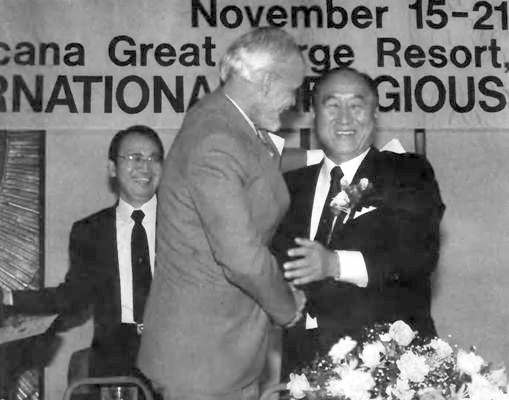
Dr.
Huston Smith greets Father at the head table.
The conference staff, mostly UTS students, had the blessing to meet every morning with Rev. Kwak, who offered valuable spiritual insights about Father's vision. He said that the most important job they could do was to unite internally with Father's heart and desire and try to develop deep, personal connections with the participants, which could be the most valuable gift the people could carry back home with them. We members should be like the roots of a tree, unseen and yet invaluably supporting the visible growth of Father's achievements. He emphasized how Father, determined to find a way to achieve harmony among religions, struggled alone through many years without real support from anyone and made many serious conditions that are only now bearing fruit.
Rev. Kwak said that the spirit world is working very closely now with people on earth, and he told an amazing story about one of the special guests at the Assembly, a man from Senegal who is the spiritual leader of several million Muslims. About two years ago this man started seeing in his prayers a vision of Father surrounded by a bright light. God told him he was a man who was going to unite the religions, and that he was in America. Even though he didn't even know Father's name or who he was, he was determined to find him. By a miracle his visa was approved and he came to New York City, and he was finally able to find our church and come to the Assembly to meet Father. He spent many hours praying for Father during the Assembly, and he told Rev. Kwak that he is now resolved to completely follow Father's instructions for him.
As a practical outcome of the Assembly, a project emerged through the IRF staff -- a program called World Youth for God, where young people of all faiths will be able to join together each summer in various third world countries to serve people in need. Assembly participants were encouraged to enlist the involvement of the religious organizations with which they were affiliated in their own countries.
In addition, some of the delegates from India were inspired to get together to discuss among themselves how they could carry back the vision of the Assembly to their own country, and how they could organize themselves to help India contribute to peace in the world.
On the final day, a closing plenary session was held in which each of the project coordinators -- Richard Payne, M. Darrol Bryant, John Maniatis, and Tyler Hendricks -- and several of the participants could express their deep feelings about the success of the conference. Each in their own unique way commented on the incredible openness and frankness they experienced in the groups, the mutual respect they developed for other faiths, the gratitude they felt towards Father, and the joy and wonder of it all. One of the participants, Dr. Chatsumarn Kabilsingh, expressed very well the potential value of this meeting. She said that this conference is something we cannot just put on the altar. It is not a completed offering; it is just a step. "The Assembly is a well-written introduction." she said. "Now we have to write the book."
The conference culminated that evening in a sumptuous farewell banquet. During the meal Father sat quietly at the head table, looking out over the sea of guests with a profound and parental gaze. Dr. Huston Smith gave some heart-felt and insightful closing remarks, cautioning that it won't be easy for the participants to explain this experience back home among their families and associates. He urged that they should make an effort to "cultivate the habit of God." training themselves and drenching themselves in "the fullness of the Divine Presence"
After that Rev. Kwak introduced Father, and then Father rose and gave his Farewell Address. Father's talk sparkled with humor and ended with a warm and embracing feeling. He said that this parting need not be a sad moment if we take what we have learned here back to the community of faith from which we came. "The coming together of our various traditions and beliefs." he explained, "much like the meeting point of the branch rivers with the main stream, is full of cross currents and sometimes pretty rough water -- but that is not a bad thing, it is to be expected. In fact, the river's flow to the great ocean will be stimulated by these many currents. For me, that great ocean, the goal of our living river, is the Kingdom of God on Earth"
After dinner the musical presentations bestowed upon the whole conference a final blessing of joy and hope. The New York City Symphony performed several new arrangements of heart-rending Middle Eastern melodies in Western symphonic form, composed by conductor David Eaton and sung by Isabella Ganz. East and West were woven together in sound in an incredible encapsulation of the spirit of the whole week of events. Another extraordinarily moving piece, composed by Kevin Pickard expressly for the Assembly and sung by Jamie Louise Baer, was presented, called "Morning of an Age' It burst out into the banquet hall like a jubilation, announcing that the long- awaited dawn is not just coming but is already here. The ancient hope that has been buried within each person was touched -- and it brought many in the room to tears.
Departure time the next morning moved many of the participants to pledge to meet their new-found friends again, hopefully at the next Assembly in 1988, when the topic will be "Responding to Our Contemporary Challenge." or even at the third Assembly in 1993, which will have the title, "Strengthening Our Hope in the Future." A new dimension of faith had been touched in all of them; a realization that the essence, the inner core, of all religions and indeed of all people on this earth is really the same.
With the unity of heart developed from these conferences, the Assembly, in conjunction with other IRF activities, hopes to initiate many new collaborations among religions and to establish centers for inter-religious dialogue and training throughout the world.